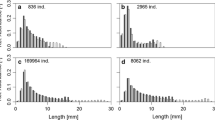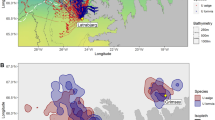Abstract
Habitat segregation among competing species is widespread yet very little is know how this is achieved in practice. In a case study, we examined short-term effects of conspecific and congeneric density on habitat selection in two competing marine isopod species, Idotea emarginata and Idotea baltica. Under semi-natural conditions in large outdoor cylindrical tanks (4 m high; volume 5.5 m3), animal groups of different size and composition had the choice between a set of relevant habitat samples (surface-floating seaweed, the water column, seaweed on the bottom). Habitat selection in both I. baltica and I. emarginata proved to be largely independent of conspecific density (level of intraspecific competition). In single-species treatments, both species showed a similar and stable pattern of distribution, with a clear preference for seaweed on the bottom. In mixed-species treatments (MST), however, the species were largely separated by habitat. While the distribution of I. emarginata was completely unaffected by the mere presence of interspecific competitors, habitat selection of I. baltica changed notably when I. emarginata was present. The habitat use patterns observed in MST conformed to those realized in geographical areas where the two species overlap in distribution: I. emarginata is dominant among decaying seaweed on the sea floor, and I. baltica is the dominant species among surface-floating seaweed. Our findings suggest that habitat segregation between the two species is essentially interactive, resulting from rapid decision-making of I. baltica with respect to habitat selection. The underlying mechanism is discussed. I. emarginata is highly superior to I. baltica in interference competition and rapidly eliminates the latter from one-habitat systems which do not allow I. baltica to escape from this interaction. In more natural, heterogeneous environments, however, I. baltica seems to be able to coexist with the superior competitor due to its broader habitat niche, flexibility in habitat selection, and a behavioural disposition to avoid normally preferred habitats when these are occupied by I. emarginata.




Similar content being viewed by others
References
Arthur WA (1982) Evolutionary consequences of interspecific competition. Adv Ecol Res 12:127–187
Boersma M, DeMeester L, Spaak P (1999) Environmental stress and local adaptation in Daphnia magna. Limnol Oceanogr 44:393–412
Bay LK, Jones GP, McCormick MI (2001) Habitat selection and aggression as determinants of spatial segregation among damselfish on a coral reef. Coral Reefs 20:289–298
Bowers MA, Thompson DB, Brown JH (1987) Spatial organization of a desert rodentcommunity: food addition and species removal. Oecologia (Berlin) 72:77–82
Branch GM (1984) Competition between marine organisms: ecological and evolutionary implications. Oceanogr Mar Biol 22:429–593
Bremset G, Heggenes J (2001) Competitive interactions in young Atlantic salmon (Salmo salar L.) and brown trout (Salmo trutta L,) in lotic environments. Nord J Freshw Res 75:127–142
Connell JH (1983) On the prevalence and relative importance of interspecific competition: evidence from field experiments. Am Nat 122:661–696
Douglass RJ (1976) Spatial interactions and microhabitat selections of two locally sympatric voles, Microtus montanus and Microtus pennsylvanicus. Ecology 57:346–352
Ebersole JP (1995) Niche separation of two damselfish species by aggression and differential microhabitat utilization. Ecology 66:14–20
Finger TR (1982) Interactive segregation among three species of sculpins (Cottus). Copeia 3:680–694
Franke H-D, Janke M (1998) Mechanisms and consequences of intra- and interspecificinterference competition in Idotea baltica (Pallas) and Idotea emarginata (Fabricius) (Crustacea: Isopoda): a laboratory study of possible proximate causes of habitatsegregation. J Exp Mar Biol Ecol 227:1–21
Fusetani N (2004) Biofouling and antifouling. Nat Prod Rep 21:94–104
Furness RW, Todd CM (1984) Diets and feeding of fulmars Fulmaris glacialis during the breeding season: a comparison between St Kilda and Shetland colonies. Ibis 126:379–387
Hairston NG (1980) The experimental test of an analysis of field distributions: competition in terrestrial salamanders. Ecology 61:817–826
Howard D, Harrison R (1984) Habitat segregation in ground crickets: the role of interspecific competition and habitat selection. Ecology 65:69–76
Ingólfsson A, Agnarsson I (2003) Amphipods and isopods in the rocky intertidal: dispersal and movements during high tide. Mar Biol 143:859–866
Jormalainen V, Tuomi J (1989) Sexual differences in habitat selection and activity of the colour polymorphic isopod Idotea baltica. Anim Behav 38:576–585
Jormalainen V, Tuomi J, Merilaita S (1992) Mate choice for male and female size in aquatic isopod Idotea balthica. Ann Zool Fenn 29:161–167
Křivan V, Sirot E (2002) Habitat selection by two competing species in a two-habitatenvironment. Am Nat 160:214–234
Larson RJ (1980) Competition, habitat selection, and the bathymetric segregation of two rockfish (Sebastes) species. Ecol Monogr 50:221–239
Lawton JM, Hassell MP (1981) Asymmetrical competition in insects. Nature 289:793–795
Lürling M, Roozen F, van Donk E, Goser B (2003) Response of Daphnia to substances released from crowded congeners and conspecifics. J Plankton Res 25:967–978
Matveev V (1993) An investigation of allelopathic effects of Daphnia. Freshw Biol 29:99–105
Naylor E (1955) The ecological distribution of British species of Idotea (Isopoda). J Anim Ecol 24:270–281
Naylor E (1972) British marine isopods. Synopses of the British Fauna (New Series) No. 3. Academic Press, London
Qian PY (1999) Larval settlement of polychaetes. Hydrobiologia 402:239–253
Robertson DR (1996) Interspecific competition controls abundance and habitat use of territorial Caribbean damselfishes. Ecology 77:885–899
Roozen F, Lürling M (2001) Behavioural response of Daphnia to olfactory cues from food, competitors and predators. J Plankton Res 23:797–808
Rosenzweig ML (1981) A theory of habitat selection. Ecology 62:327–335
Salemaa H (1979) Ecology of Idotea spp. (Isopoda) in the northern Baltic. Ophelia 18:133–150
Schluter D (2000) Ecological character displacement in adaptive radiation. Am Nat 156:S4–S16
Schoener TW (1983) Field experiments on interspecific competition. Am Nat 122:240–285
Schoener TW (1986) Resource partitioning. In: Kikkawa J, Anderson DJ (eds) Community ecology: pattern and process. Blackwell, Oxford, pp 91–126
Slatkin M (1984) Ecological causes of sexual dimorphism. Evolution 38:622–630
Sone S, Inoue M, Yanagisawa Y (2001) Habitat use and diet of two stream gobies of the genus Rhinogobius in south-western Shikoku, Japan. Ecol Res 16:205–219
Steinberg PD, de Nys R (2002) Chemical mediation of colonization of seaweed surfaces. J Phycol 38:621–629
Suhling F (1996) Interspecific competition and habitat selection by the riverine dragonfly Onychogomphus uncatus. Freshw Biol 35:209–217
Thiel M, Gutow L (2005a) The ecology of rafting in the marine environment. I. The floating substrata. Oceanogr Mar Biol 42:181–263
Thiel M, Gutow L (2005b) The ecology of rafting in the marine environment. II. The rafting organisms and community. Oceanogr Mar Biol 43:279–418
Wallerstein BR, Brusca RC (1982) Fish predation: a preliminary study of its role in the zoogeography and evolution of shallow water idoteid isopods (Crustacea: Isopoda: Idoteidae). J Biogeogr 9:135–150
Werner EE, Hall DJ (1977) Competition and habitat shift in two sunfish (Centrarchidae). Ecology 60:256–264
Zar JH (1999) Biostatistical analysis, 4th edn. Prentice-Hall, Upper Saddle River, NJ
Author information
Authors and Affiliations
Corresponding author
Additional information
Communicated by O. Kinne, Oldendorf/Luhe
Rights and permissions
About this article
Cite this article
Franke, HD., Gutow, L. & Janke, M. Flexible habitat selection and interactive habitat segregation in the marine congeners Idotea baltica and Idotea emarginata (Crustacea, Isopoda). Mar Biol 150, 929–939 (2007). https://doi.org/10.1007/s00227-006-0421-2
Received:
Accepted:
Published:
Issue Date:
DOI: https://doi.org/10.1007/s00227-006-0421-2




